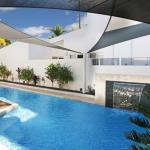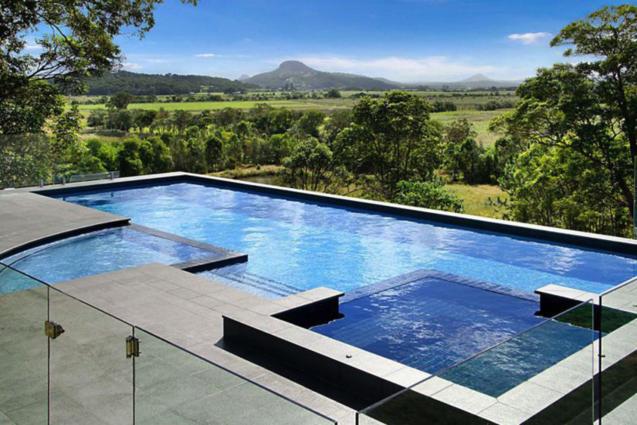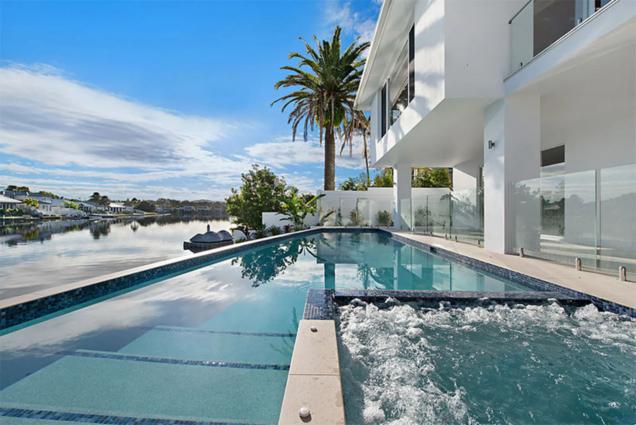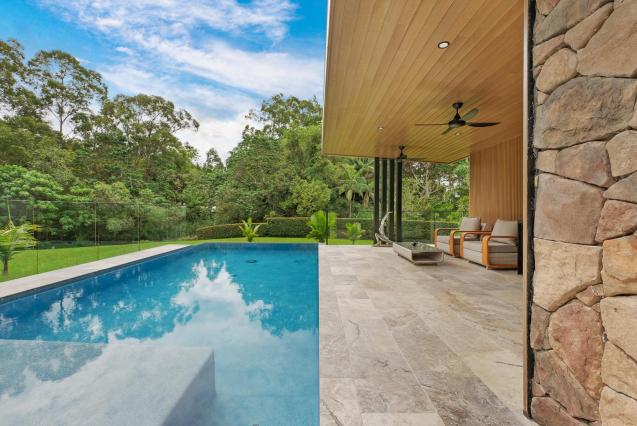
How to Look After Your Swimming Pool During El Niño
By Ecozen Pools + Landscapes|August 22, 2023
Imagine a crystal-clear water, laughter echoing in the backyard, and sizzling barbeques – all the hallmarks of a perfect Aussie summer by the pool. But hang on, there's an unexpected guest crashing the pool party – El Nino! Before you start scratching your head, let me fill you in.
El Nino is a weather phenomenon that brings scorching temperatures and droughts to our land down under. And you know what that means? It's time to buckle up and get our pools in tip-top shape to beat the heat and keep the good times flowing!
El Niño and Its Impact on Swimming Pools
El Niño, also known as ENSO (El Niño-Southern Oscillation), is a naturally occurring phenomenon that happens every few years, causing changes in global weather patterns. The phenomenon happens when trade winds shift due to changes in ocean temperature and atmospheric pressure, causing warmer water to move eastwards in the Pacific Ocean. This warmer water then brings with it a number of weather-related effects, including droughts in Australia.
While El Niño is not solely responsible for causing droughts in Australia, it has a significant impact on the severity and frequency of these events. During an El Niño event, Australia typically experiences hotter and drier conditions, with rainfall patterns becoming more unpredictable. This leads to a number of issues for Australian homeowners, particularly those with swimming pools.
The effects of El Niño on pool water levels and quality are well-documented. First and foremost, the increased heat and dryness caused by the phenomenon leads to greater evaporation of pool water. This means homeowners must refill their pools more often, which can be costly and time-consuming.
Additionally, the hotter and drier conditions during an El Niño event can lead to more concentrated chemicals in pool water. This happens because the pool water evaporates more quickly, leaving behind a higher concentration of chemicals. This can lead to imbalances in pH levels, potentially causing itching and irritation for swimmers. Chemical levels must be carefully monitored during an El Niño event to ensure they remain within safe levels.
The increased heat and dryness during an El Niño event can cause algae blooms in swimming pools. Algae thrives in warm water and sunlight, and if not properly addressed, can cause problems for homeowners. The key to preventing algae growth is to maintain proper chemical levels and keep the pool clean and well-circulated.
Conserving Water
As a pool hero, you can take simple steps to reduce water consumption and conserve this precious resource.
Having a concrete pool in your backyard is great, but it comes with responsibilities. A significant part of pool ownership is ensuring that the water is safe, clean, and hygienic. One of the essential steps in maintaining water quality is regular water testing. By testing and adjusting the pool's chemical balance, you can prevent algae growth, maintain water clarity, and keep everyone who swims in it safe.
Why is regular water testing necessary?
Keeping the chemical balance in your pool within the optimal range is essential for the overall health of swimmers and the longevity of the pool. If the pH level is too high or too low, the water can become corrosive, which can damage the pool liner and metal parts. Extreme pH levels can also cause skin irritation to swimmers.
Similarly, a high level of chlorine can cause skin and eye irritation. On the other hand, low levels of chlorine can fail to kill bacteria and remove impurities from the water, posing a risk to swimmers' health. With regular water testing, you can monitor and adjust the pH level, chlorine, and other chemicals, keeping the water safe and hygienic.
How to test and adjust pH levels and chlorine?
You can use a pool water test kit to check and adjust the pH and chlorine levels. The kit will help you keep track of the chemical balance, and you can add necessary adjustments to keep the water within the optimal range. Here's a simple guide on how to test and adjust pH levels and chlorine:
Traditional pool chemicals, such as chlorine and algaecide, can harm the environment if not used correctly. Fortunately, there are eco-friendly alternatives that can keep the pool safe and clean without harming the environment. Here are some eco-friendly alternatives that you can use:
Nobody wants to be stuck with a pool that’s out of commission during the hottest months of the year, so here are some tips to help you stay ahead of the game.
For starters, it’s important to inspect your pool equipment regularly. This includes your pool pump, filters, and other components. Inspecting your pool equipment will allow you to detect any potential problems early on, before they escalate into more significant issues. Check for any visible signs of wear or damage and ensure that everything is functioning as it should. Regular inspection of your pool equipment is key in identifying any minor problems before they become major issues.
In addition to regular inspections, it’s also important to schedule professional pool maintenance to help prevent issues from arising in the first place. Professional pool maintenance can help keep your pool equipment in optimal condition, ensuring that everything runs smoothly throughout the year. A professional pool maintenance service can identify and address any potential issues early on, preventing costly repairs down the line.
Scheduling a regular maintenance service can also help to keep your pool equipment operating efficiently, which can save you money in the long run. An efficient pool pump, for example, will use less energy and save you money on your utility bills. Regular maintenance will help keep your equipment running as efficiently as possible, which can ultimately save you money.
Another aspect of preventative maintenance is keeping your pool clean. Regular cleaning and maintenance of your pool can help prevent debris from clogging your filters, which can lead to equipment malfunctions. Debris buildup can also cause your pool equipment to work harder than it needs to, which can ultimately lead to equipment failure. Keep your pool clean and well-maintained to help keep your equipment running smoothly.
Conclusion
With pool covers, water conservation, the right products, and a bit of elbow grease, you'll be ready to take on whatever El Nino throws your way. Remember, a well-maintained pool is a happy pool, and happy pools mean happy pool-goers!
Looking to have your dream swimming pool built? Get in touch with award-winning Brisbane pool builders, Ecozen. Specialists in Brisbane pool & landscape packages.
El Nino is a weather phenomenon that brings scorching temperatures and droughts to our land down under. And you know what that means? It's time to buckle up and get our pools in tip-top shape to beat the heat and keep the good times flowing!
El Niño and Its Impact on Swimming Pools
El Niño, also known as ENSO (El Niño-Southern Oscillation), is a naturally occurring phenomenon that happens every few years, causing changes in global weather patterns. The phenomenon happens when trade winds shift due to changes in ocean temperature and atmospheric pressure, causing warmer water to move eastwards in the Pacific Ocean. This warmer water then brings with it a number of weather-related effects, including droughts in Australia.
While El Niño is not solely responsible for causing droughts in Australia, it has a significant impact on the severity and frequency of these events. During an El Niño event, Australia typically experiences hotter and drier conditions, with rainfall patterns becoming more unpredictable. This leads to a number of issues for Australian homeowners, particularly those with swimming pools.
The effects of El Niño on pool water levels and quality are well-documented. First and foremost, the increased heat and dryness caused by the phenomenon leads to greater evaporation of pool water. This means homeowners must refill their pools more often, which can be costly and time-consuming.
Additionally, the hotter and drier conditions during an El Niño event can lead to more concentrated chemicals in pool water. This happens because the pool water evaporates more quickly, leaving behind a higher concentration of chemicals. This can lead to imbalances in pH levels, potentially causing itching and irritation for swimmers. Chemical levels must be carefully monitored during an El Niño event to ensure they remain within safe levels.
The increased heat and dryness during an El Niño event can cause algae blooms in swimming pools. Algae thrives in warm water and sunlight, and if not properly addressed, can cause problems for homeowners. The key to preventing algae growth is to maintain proper chemical levels and keep the pool clean and well-circulated.
Conserving Water
As a pool hero, you can take simple steps to reduce water consumption and conserve this precious resource.
- Cover Your Pool: One of the easiest ways to reduce water evaporation is to cover your pool when it's not in use. Not only will this decrease your water consumption, but it will also prevent debris from entering the water. By covering your pool, you can save up to 30% of the water that would otherwise evaporate.
- Use a Rainwater Harvesting System: During the rainy season, you can collect rainwater and use it to top up your pool. This is a great way of conserving water, as it reduces your reliance on municipal sources. Installing a rainwater harvesting system is inexpensive, and the water that you collect can be filtered and treated to make it suitable for use in your pool.
- Check for Leaks: A leaky pool can waste a lot of water over time. Therefore, it's important to regularly check your pool for leaks. You can do this by checking the water level in your pool and observing if it remains constant. If the water level drops, there is a good chance that there is a leak. Fixing a leaky pool can save you hundreds of gallons of water each month.
- Use Water Carefully: Whether you're topping up your pool, or cleaning it, use water wisely. When adding water to your pool, make sure to do it slowly to reduce the amount of splashing. When cleaning your pool, try to use a pool skimmer to remove debris instead of relying solely on your pool's filtration system.
Having a concrete pool in your backyard is great, but it comes with responsibilities. A significant part of pool ownership is ensuring that the water is safe, clean, and hygienic. One of the essential steps in maintaining water quality is regular water testing. By testing and adjusting the pool's chemical balance, you can prevent algae growth, maintain water clarity, and keep everyone who swims in it safe.
Why is regular water testing necessary?
Keeping the chemical balance in your pool within the optimal range is essential for the overall health of swimmers and the longevity of the pool. If the pH level is too high or too low, the water can become corrosive, which can damage the pool liner and metal parts. Extreme pH levels can also cause skin irritation to swimmers.
Similarly, a high level of chlorine can cause skin and eye irritation. On the other hand, low levels of chlorine can fail to kill bacteria and remove impurities from the water, posing a risk to swimmers' health. With regular water testing, you can monitor and adjust the pH level, chlorine, and other chemicals, keeping the water safe and hygienic.
How to test and adjust pH levels and chlorine?
You can use a pool water test kit to check and adjust the pH and chlorine levels. The kit will help you keep track of the chemical balance, and you can add necessary adjustments to keep the water within the optimal range. Here's a simple guide on how to test and adjust pH levels and chlorine:
- Test the pH level- Using a test kit, dip a testing strip into the pool water and wait for a few seconds. The strip will change colour, and you can match it with the colour chart provided in the test kit. If the pH level is too low, use pH increaser or baking soda to raise it. If it is too high, use pH decreaser or muriatic acid to bring it down.
- Test the chlorine level- Using a test kit, dip another strip into the water and wait for a few seconds. The strip will change colour, and you can match it with the colour chart provided in the test kit. If the chlorine level is too low, add more chlorine to the pool. If it is too high, let it dissipate by itself.
- Test other chemicals- Besides pH and chlorine, you should also test other chemicals such as alkalinity, calcium hardness, and cyanuric acid. Follow the instructions on the test kit to add the necessary chemicals to maintain the optimal range.
Traditional pool chemicals, such as chlorine and algaecide, can harm the environment if not used correctly. Fortunately, there are eco-friendly alternatives that can keep the pool safe and clean without harming the environment. Here are some eco-friendly alternatives that you can use:
- Saltwater systems- Instead of using traditional chlorine, you can install a saltwater system that produces chlorine from salt. Saltwater systems require less maintenance and produce fewer harmful byproducts than traditional chlorine.
- Natural enzymes- You can use natural enzymes that break down organic matter in the water and reduce the need for chlorine. Enzyme-based products are safe for the environment and do not harm swimmers.
- Solar covers- Solar covers help to retain heat in the pool and prevent debris and algae growth. Solar covers reduce the need for chemicals and saves energy by reducing the need for pool heaters.
Nobody wants to be stuck with a pool that’s out of commission during the hottest months of the year, so here are some tips to help you stay ahead of the game.
For starters, it’s important to inspect your pool equipment regularly. This includes your pool pump, filters, and other components. Inspecting your pool equipment will allow you to detect any potential problems early on, before they escalate into more significant issues. Check for any visible signs of wear or damage and ensure that everything is functioning as it should. Regular inspection of your pool equipment is key in identifying any minor problems before they become major issues.
In addition to regular inspections, it’s also important to schedule professional pool maintenance to help prevent issues from arising in the first place. Professional pool maintenance can help keep your pool equipment in optimal condition, ensuring that everything runs smoothly throughout the year. A professional pool maintenance service can identify and address any potential issues early on, preventing costly repairs down the line.
Scheduling a regular maintenance service can also help to keep your pool equipment operating efficiently, which can save you money in the long run. An efficient pool pump, for example, will use less energy and save you money on your utility bills. Regular maintenance will help keep your equipment running as efficiently as possible, which can ultimately save you money.
Another aspect of preventative maintenance is keeping your pool clean. Regular cleaning and maintenance of your pool can help prevent debris from clogging your filters, which can lead to equipment malfunctions. Debris buildup can also cause your pool equipment to work harder than it needs to, which can ultimately lead to equipment failure. Keep your pool clean and well-maintained to help keep your equipment running smoothly.
Conclusion
With pool covers, water conservation, the right products, and a bit of elbow grease, you'll be ready to take on whatever El Nino throws your way. Remember, a well-maintained pool is a happy pool, and happy pools mean happy pool-goers!
Looking to have your dream swimming pool built? Get in touch with award-winning Brisbane pool builders, Ecozen. Specialists in Brisbane pool & landscape packages.



